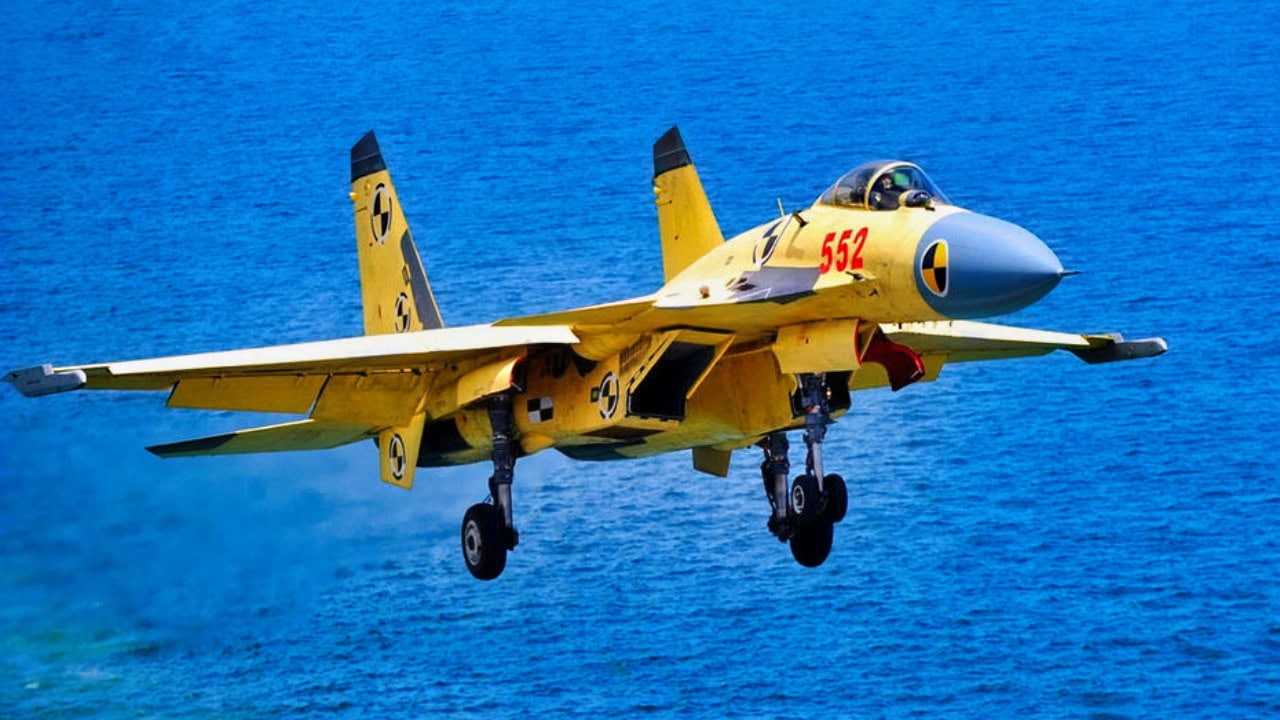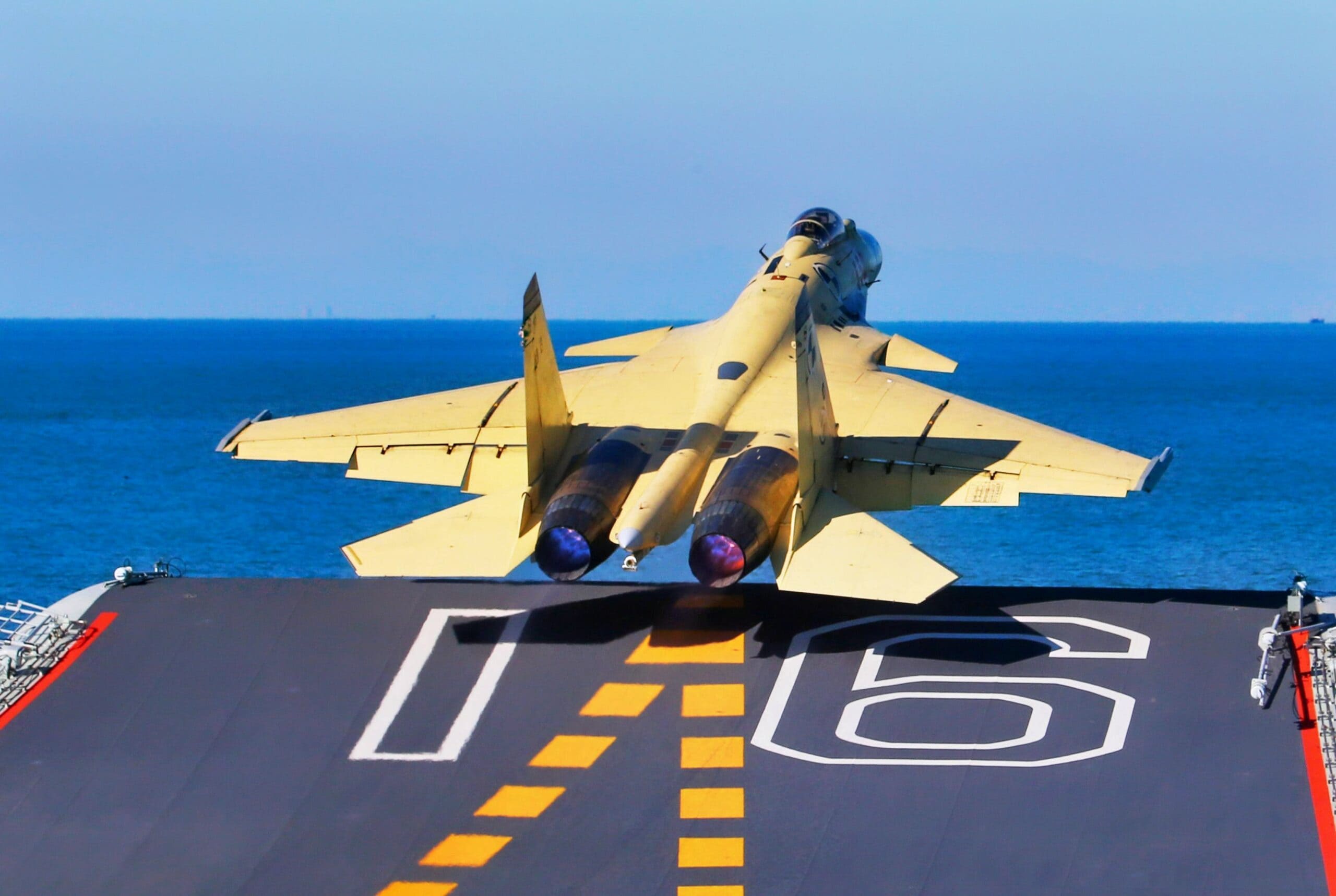Summary and Key Points: China’s J-15 “Flying Shark” is its first operational carrier-based fighter, derived from Russian designs like the Su-33 but utilizing more composite materials.
-While less capable than Western counterparts and currently hampered by the ski-jump launch system on China’s initial carriers (like the Liaoning), the J-15 is significant.
-It represents Beijing’s naval aviation ambitions and serves as a crucial interim platform for developing pilot skills and operational experience.
-Viewed as a stepping stone towards the stealth J-35 and future flat-top carriers, the J-15, despite its limitations and causing regional unease, is considered successful in building China’s foundational carrier capabilities.
China’s J-15 Flying Shark in 1 Word: Copycat?
China’s J-15 “Flying Shark” is the first in service with China: a carrier-based fighter-bomber serving China’s first aircraft carrier.
Though the J-15 is less capable than carrier fighters in service with the United States, Russia, France, or other countries that operate aircraft carriers, it is significant for what it represents: the intentions of Beijing to eventually field a powerful blue-water navy with robust power projection capabilities.
J-15 Flying Shark, Explained
Photos of China’s J-15 came to light in 2011. The aircraft is broadly similar to Russia’s Su-33, a carrier-capable multirole and air superiority fighter.
But the J-15’s origin story begins with the J-11, a Chinese-made version of Russia’s Su-27UBK, possibly violating the production license agreement.
Building on the J-11, the Flying Shark uses a greater degree of composite materials in its construction, lightening the fighter, allowing for an increase in payload compared to the Su-33 and better flight performance.
Wiser heads have pointed out that although China’s first two carriers certainly limit the jet’s performance, another weakness would be the carrier’s reliance on helicopters for airborne early warning, an area in which Chinese technology struggles compared to, say, the United States.
However, the carrier limitation is set to change, potentially a boon for the J-15 fighter.
The Liaoning Aircraft Carrier
The Flying Shark is, in some respects, the centerpiece of China’s Liaoning aircraft carrier, the country’s first.
Though the Liaoning’s roll-out and entry into service have been successful, the carrier’s design limits the J-15’s capabilities to some extent.
Thanks to the carrier’s ski jump, flying the J-15 with heavier payloads might be somewhat limited, as take-off would put a great deal of strain on the aircraft’s wings and fuselage, particularly when full and all hard points are equipped.
There are a considerable number of factors that determine how effective the J-15 would or would not be in a conflict situation. While payload is somewhat limited thanks to the ski jump design of China’s first two aircraft carriers, the J-15 could actually see an increase in performance when flying on later skiless carriers like the Fujian or upcoming Type 004 flattops.
But an expansion of capabilities at sea had a consequence: China’s neighbors, particularly Japan, South Korea, and the Philippines observed China’s carrier building and the J-15 with trepidation, seeing a risk to their interests in the near future.
The Flying Shark Made History
The J-15, therefore, represents China’s initial foray into naval aviation. While it was a significant step for China as a platform, its abilities are limited in scope, partly thanks to its launch platform’s ski jump.

J-15 Flying Shark Fighter from China.
Instead of looking at the Flying Shark in terms of raw capabilities, it’s useful to remember its role as the first naval aviation asset for China’s fledgling maritime aviation capabilities—which are nevertheless growing.
Seen in those terms, the Flying Shark is an interim jet, designed not to go toe-to-toe with the best navies elsewhere in the world but rather to build skills and serve as an interim platform until the J-15’s stealthy fifth-generation successor, the J-35, enters service with the PLAN.
Through that lens, the J-15 has been rather successful.
About the Author: Caleb Larson
Caleb Larson is an American multiformat journalist based in Berlin, Germany. His work covers the intersection of conflict and society, focusing on American foreign policy and European security. He has reported from Germany, Russia, and the United States. Most recently, he covered the war in Ukraine, reporting extensively on the war’s shifting battle lines from Donbas and writing on the war’s civilian and humanitarian toll. Previously, he worked as a Defense Reporter for POLITICO Europe. You can follow his latest work on X.

